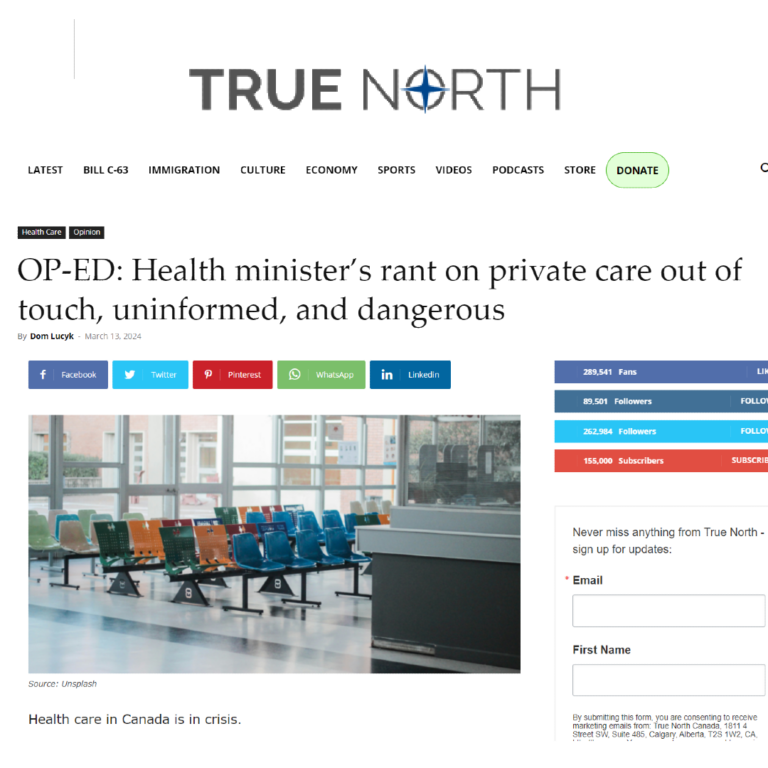TRUE NORTH COLUMN: Health minister’s rant on private care out of touch, uninformed, and dangerous

Health care in Canada is in crisis.
That’s a fact. But apparently, not one recognized by the Trudeau government.
In response to a question about a recent Ipsos poll that showed 42 per cent of Canadians would go to the United States to pay for health care to avoid long waits, federal Health Minister Mark Holland went on a nonsensical rant. In fact, his remarks reveal a dangerous attitude at the very top of Canada’s federal government.
Holland began his response with a clear denunciation of the idea that patients should have the right to pay to improve their health.
“I would say that, you know, health systems that have operated on this model, are an abject disaster,” he said.
Is that really so? Which countries would Minister Holland happen to be referring to?
Sweden, for instance, operates a universal, government-run system, but allows patients to pay for private care if they so choose. A study from the progressive-leaning Commonwealth Fund showed that, despite spending roughly the same amount of money per capita on health care as Canada, Sweden’s system performed better. Same for the Netherlands, the U.K., Switzerland and France.
New Zealand and Australia both spent less than Canada and far outperformed our system.
All of these countries provide universal healthcare while allowing patients to pay for care if they so choose. Does Canada’s health minister not know this or is he deliberately trying to mislead Canadians?
What’s even worse is Holland’s minimization of the suffering and death Canadian patients are facing in our health system.
“I would say to folks, most of the waiting that is occurring is for either elective procedures or for procedures that are non, not an emergency circumstance, that people be patient with those,” he said.
The disconnect from reality and disregard for patients is, frankly, shocking. One has to wonder if Holland would look someone like retired nurse Judy Anderson in the eye and tell her to be patient.
Both of the Ontario woman’s adult daughters died waiting months for heart surgeries that could have saved their lives. Ontario health data show that since 2013, there have been 931 patients who died while waiting for cardiac treatment in the province – 244 of whom waited longer than the maximum recommended wait time.
People like Kim Purdy, Jerry Agar and Sharon Kilkenny have suffered from chronic physical and emotional pain thanks to long waits for joint replacements. Would ‘patience’ have helped any of them out? They’re also far from alone. SecondStreet.org data show that over 17,000 Canadians died waiting for various surgeries and diagnostic scans just last year.
The Fraser Institute has been tracking median wait times since 1993. Over the last 30 years, wait times have nearly tripled to 27.7 weeks. Over the same period, government spending in Canada – on a per person basis – has increased at nearly double the rate of inflation.
More money, longer wait times. Clearly, throwing money at the system hasn’t worked.
Perhaps the health minister would be wise to spend some more time looking at the data and hearing what patients are going through, instead of fear mongering about reform.
“We cannot have people begin spending money in private systems or private models. That’ll be the end of quality care for all of us,” he concluded.
As demonstrated, he’s clearly wrong that allowing patients the right to choose would somehow detract from the universal system. Perhaps sharing falsehoods like this is easier when you don’t have to rely on the Canadian system. If Holland was diagnosed with cancer or had chronic hip pain, he could afford care in the U.S. on his taxpayer-funded salary of nearly $300,000.
Though it’s possible a politician in his position may not face the same long waits as everyone else, given his influence on the system.
Years of pain and suffering, or maybe death, for many everyday Canadians, with the only real option for access to timely care coming from outside of the country. It’s hard not to call a system like that an ‘abject disaster.’
Dom Lucyk is the Communications Director for SecondStreet.org, a Canadian think tank.
This column was originally published in True North on March 13, 2024.
You can help us continue to research and tell stories about this issue by making a donation or sharing this content with your friends. Be sure to sign up for our updates too!


